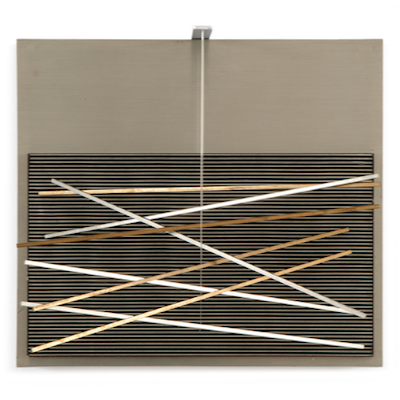
Details
Artist
Styles
Lithograph in colors // Alexander Calder's Lune jaune et porc qui pique (1963) is a vibrant lithograph that showcases his playful, abstract aesthetic. The artwork features two distinct abstract forms, each rendered in bold, primary colors such as red, blue, yellow, green, and black. The left figure has a whimsical, tree-like structure with a crescent moon and heart shape on top, while the right figure is a dynamic composition of intersecting geometric shapes. Calder’s use of fluid lines and color blocks creates a sense of motion and spontaneity, reminiscent of his famous mobiles and kinetic sculptures. This limited edition lithograph, with its vivid palette and expressive forms, exemplifies Calder's ability to translate his three-dimensional art concepts into two-dimensional works, maintaining the same sense of movement and vitality.
Lune jaune et porc qui pique, 1963
form
Medium
Size
46.7 x 60.3 cm
- Inches
- Centimeters
Edition
Price
Details
Artist
Styles
Lithograph in colors // Alexander Calder's Lune jaune et porc qui pique (1963) is a vibrant lithograph that showcases his playful, abstract aesthetic. The artwork features two distinct abstract forms, each rendered in bold, primary colors such as red, blue, yellow, green, and black. The left figure has a whimsical, tree-like structure with a crescent moon and heart shape on top, while the right figure is a dynamic composition of intersecting geometric shapes. Calder’s use of fluid lines and color blocks creates a sense of motion and spontaneity, reminiscent of his famous mobiles and kinetic sculptures. This limited edition lithograph, with its vivid palette and expressive forms, exemplifies Calder's ability to translate his three-dimensional art concepts into two-dimensional works, maintaining the same sense of movement and vitality.
- Recently Added
- Price (low-high )
- Price (high-low )
- Year (low-high )
- Year (high-low )
Alexander Calder
Le Piège (from La Memoire Elementaire), 1976
Limited Edition Print
Lithograph
USD 9,700
Alexander Calder
Hommage á Euclide / Hommage To Euclid From La Memoire Elementaire, 1976
Limited Edition Print
Lithograph
USD 9,700
Alexander Calder
Untitled (from The La Memoire Elementaire), 1976
Limited Edition Print
Lithograph
USD 2,600
Alexander Calder
Taches De Rousser (from La Memoire Elementaire), 1976
Limited Edition Print
Lithograph
USD 9,700
Alexander Calder
Red, Yellow And Blue Coral With Shells , c. 1970
Limited Edition Print
Lithograph
Inquire For Price
Alexander Calder
McGovern For McGovernment , 1973
Limited Edition Print
Lithograph
Inquire For Price
Alexander Calder
Le Bateau Lavoir (The Laundry Boat), 1969
Limited Edition Print
Lithograph
USD 4,000
Alexander Calder
Our Unfinished Revolution: Animals, 1976
Limited Edition Print
Lithograph
Inquire For Price
Alexander Calder
Le Point De Non Retour (from La Memoire Elementaire), 1976
Limited Edition Print
Lithograph
USD 9,700
Alexander Calder
La Pointe Du Progrès (from La Memoire Elementaire), 1976
Limited Edition Print
Lithograph
USD 9,700
Alexander Calder
Our Unfinished Revolution: Octopus/Squid, 1975-1976
Limited Edition Print
Lithograph
USD 9,700
Alexander Calder
Untitled (Spirals And Forms), 1965
Limited Edition Print
Lithograph
Currently Not Available
What is kinetic art?
Kinetic art is an international movement that emerged in the 1920s and gained prominence in the 1960s, referring to art that involves both apparent and real motion. It encompasses any medium that includes movement, either relying on actual motion for its effect or being perceived as moving by the viewer. Early examples include canvas paintings designed to create optical illusions of movement. Today, kinetic art often refers to three-dimensional figures and sculptures, such as those operated by machines or those that move naturally. The movement covers a variety of styles and techniques that frequently overlap.





























































